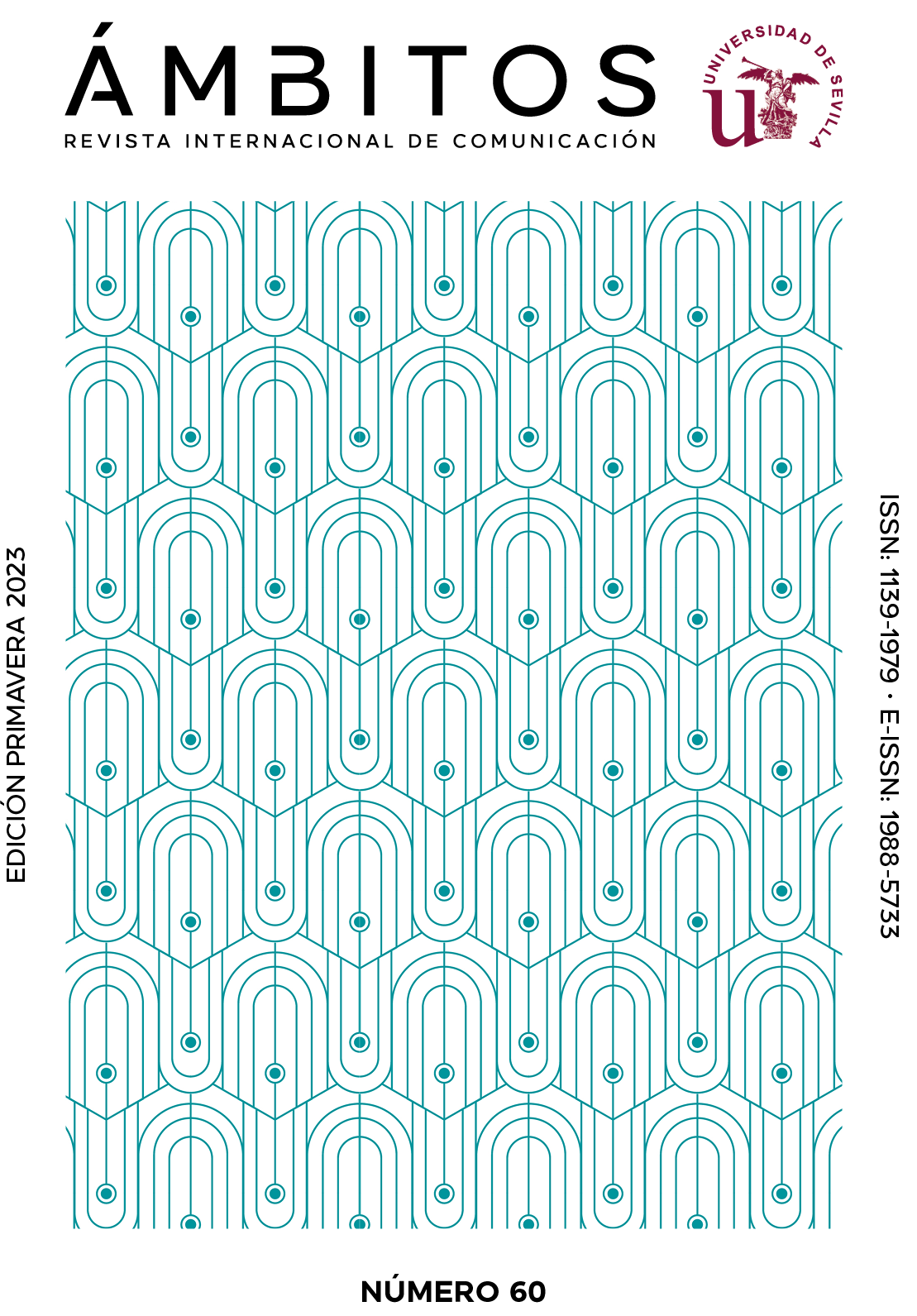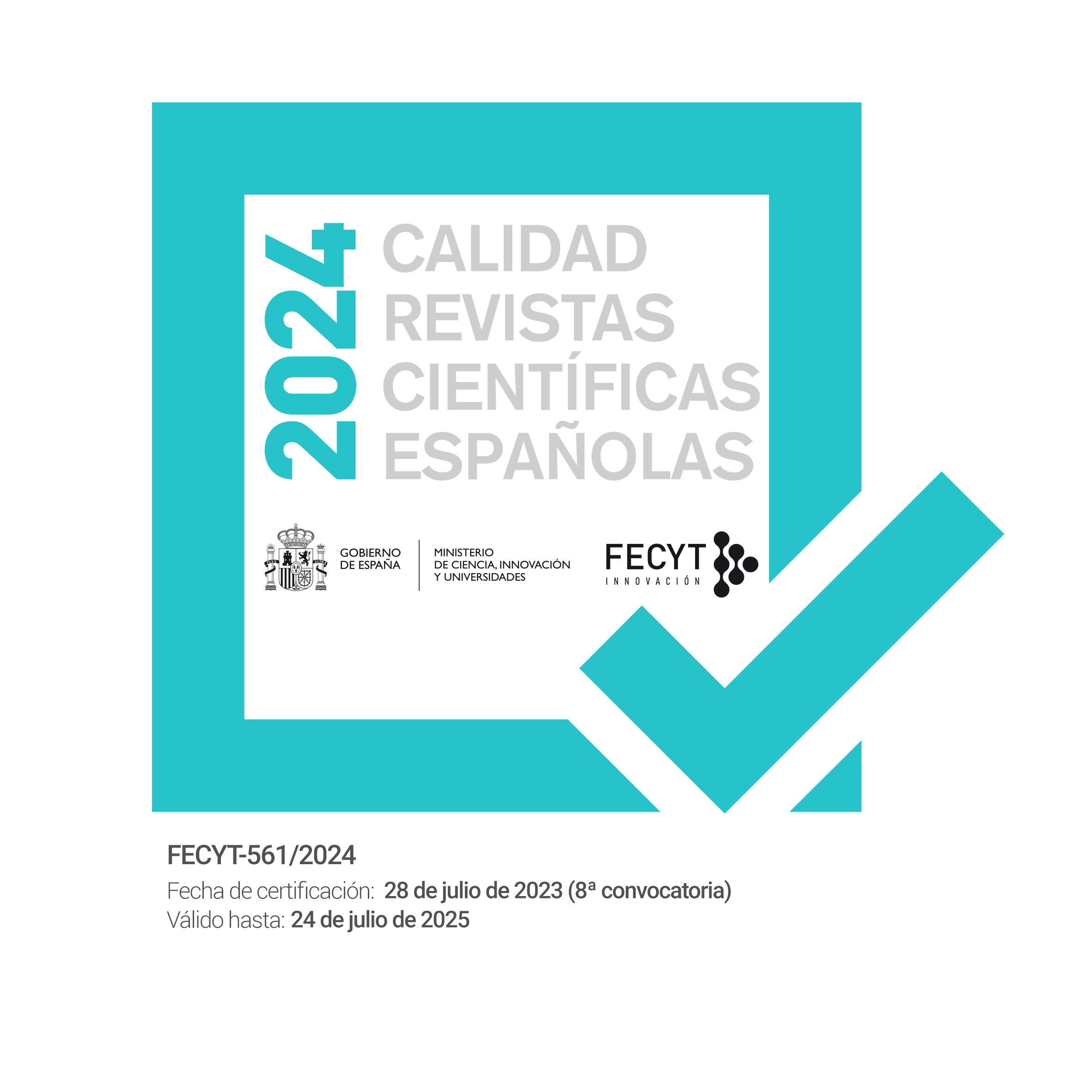Comunicación política en TikTok: Podemos y VOX a través de los vídeos cortos
DOI:
https://doi.org/10.12795/Ambitos.2023.i60.04Palabras clave:
comunicación política, TikTok, redes sociales, VOX, PodemosResumen
Los partidos políticos, conscientes de la importancia que los públicos más jóvenes tienen como potenciales votantes, han dirigido sus estrategias comunicativas a TikTok, una de las redes sociales más atractivas para los menores de entre 12 y 17 años. Mediante análisis de contenido de los 50 vídeos cortos con más reproducciones de cada una de las cuentas oficiales de TikTok de Podemos y VOX (@ahorapodemos y @vox_espana), esta investigación propone examinar el uso que ambos partidos hacen de dicha red, analizando si adaptan su estrategia comunicativa a las particularidades de esta plataforma y comparando si existen diferencias en el tipo de contenidos que se difunde en ella en función del distinto signo ideológico de cada formación. Los resultados reflejan que, aunque las formaciones políticas analizadas emplean algunos estilemas propios de TikTok, como la duración corta o la biblioteca de sonidos, el carácter propagandístico preponderante en los contenidos choca con el tono desenfadado y lúdico que caracteriza a la popular plataforma de vídeos cortos y que le ha otorgado popularidad entre el público juvenil. Aunque se detectan diferencias estratégicas en función de la polaridad ideológica, en general, la comunicación política desarrollada por Podemos y VOX en esta red social, estarían aún en una fase embrionaria a espera de desarrollar su potencial a través de contenidos más ligeros que conecten con mayor facilidad con los jóvenes usuarios mayoritarios en TikTok.
Descargas
Citas
Abejón-Mendoza, P. y Mayoral-Sánchez, J. (2017). Persuasión a través de Facebook de los candidatos en las elecciones generales de 2016 en España. Profesional de La información, 26(5), 928–936. https://doi.org/10.3145/epi.2017.sep.14
Aguirre Quezada, J. P. y Gómez Macfarland, C. A. (2019). La formación cívica de la generación alfa. Pluralidad y consenso, 8(37), 46-55.
Aladro Vico, E. y Requeijo Rey, P. (2020). Discurso, estrategias e interacciones de Vox en su cuenta oficial de Instagram en las elecciones del 28-A. Derecha radical y redes sociales. Revista Latina de Comunicación Social, 77, 203–229. https://doi.org/10.4185/RLCS-2020-1455
Alonso-López, N.; Sidorenko-Bautista, P. y Giacomelli, F. (2021). Beyond challenges and viral dance moves: TikTok as a vehicle for disinformation and fact-checking in Spain, Portugal, Brazil, and the USA. Anàlisi: Quaderns de Comunicació i Cultura, 64, 65-84. https://doi.org/10.5565/rev/analisi.3411
Alonso-Muñoz, L. y Casero-Ripollés, A. (2018). Political agenda on Twitter during the 2016 Spanish elections: issues, strategies, and users’ responses. Communication & Society, 31(3), 7-25.
Alonso-Muñoz, L., Marcos-García, S. y Casero-Ripollés, A. (2017). Political leaders in (inter)action. Twitter as a strategic communication tool in electoral campaigns. Tripodos, (39), 71-90. http://www.tripodos.com/index.php/Facultat_Comunicacio_Blanquerna/article/view/381
Ariza, A., March, V. y Torres, S. (2022). Horacio “tiktoker”: un análisis de los discursos, herramientas, temas y contenidos en la comunicación política del jefe de Gobierno porteño en TikTok. Austral Comunicación, 11(1). https://doi.org/10.26422/aucom.2022.1101.ari
Ballesteros Herencia, C. A. y Díez-Garrido, M. (2018). Tenemos que hablar. El Compromiso 2.0 en Facebook durante la cibercampaña española del 20D de 2015. Communication & society, 31(1), 169-193. https://doi.org/10.15581/003.31.35717
Berrocal Gonzalo S., Campos Domínguez E. y Redondo García M. (2012a). Comunicación Política en Internet: La tendencia al “infoentretenimiento” político en "YouTube". Estudios sobre el Mensaje Periodístico, 18(2), 643-659. https://doi.org/10.5209/rev_ESMP.2012.v18.n2.41037
Berrocal-Gonzalo, S., Martín-Jiménez, V. y Gil-Torres, A. (2017). Líderes políticos en YouTube: información y politainment en las elecciones generales de 2016 (26J) en España. Profesional de la información, 26(5), 937–946. https://doi.org/10.3145/epi.2017.sep.15
Berrocal, S., Campos Domínguez, E. y Redondo García, M. (2012b). El “infoentretenimiento” político en Internet: La presencia de cinco líderes europeos en YouTube. RIPS: Revista de Investigaciones políticas y sociológicas, 11(4). https://revistas.usc.gal/index.php/rips/article/view/697
Campos-Domínguez, E. (2017). Twitter y la comunicación política. Profesional de La información, 26(5), 785–794. https://doi.org/10.3145/epi.2017.sep.01
Castro Martínez, A. y Díaz Morilla, P. (2021). La comunicación política de la derecha radical en redes sociales. De Instagram a TikTok y Gab, la estrategia digital de Vox. Dígitos. Revista de Comunicación Digital, 1(7), 67-89. http://dx.doi.org/10.7203/rd.v1i7.210
Cervi, L. y Marín-Lladó, C. (2021). What are political parties doing on TikTok? The Spanish case. Profesional de la información (EPI), 30(4). https://doi.org/10.3145/epi.2021.jul.03
Cervi, L., Tejedor, S. y Marín Lladó, C. (2021). TikTok and the new language of political communication. Cultura, Lenguaje Y Representación, 26, 267-287. https://doi.org/10.6035/clr.5817
Cusot Cerda, G. R. y Palacios Arias, I. C. (2021). Tik Tok y su Rol Predominante en la Campaña Presidencial de Xavier Hervas. Revista Enfoques de la Comunicación, (6), 65-96.
Esser, F., y Pfetsch, B. (2020). Comparing political communication: A 2020 update. Comparative politics, 5, 336-358.
Fenoll, V. y Cano-Orón, L. (2017). Participación ciudadana en los perfiles de Facebook de los partidos españoles. Análisis de comentarios en la campaña electoral de 2015. Communication & Society, 30 (4), 2017, 131-148. https://doi.org/10.15581/003.30.35763
Gamir-Ríos, J. y Sánchez-Castillo, S. (2022). La irrupción política del vídeo corto. ¿Es TikTok una nueva ventana para los partidos españoles? Communication & Society, 35(2), 37-52.
Gil Ramírez, M. (2019). ¿Participa la esfera política en YouTube? Producción y consumo de información en la campaña electoral catalana de 2017. Ámbitos. Revista Internacional De Comunicación, (44), 141–161. https://doi.org/10.12795/Ambitos.2019.i44.09
Gil Ramírez, M., Castillero Ostio, E., y Gómez de Travesedo Rojas, R. (2020). Imagen y título de portada como elementos estratégicos de comunicación política en YouTube: uso por parte de la esfera política española. AdComunica, 255-282. https://doi.org/10.6035/2174-0992.2020.20.11
Gil Ramírez, M., y Gómez de Travesedo Rojas, R. (2020). Gestión de la política española en YouTube. Una asignatura pendiente. Observatorio (OBS*), 14(1).
Gil Ramírez, Marta (2019). El uso de YouTube en el Procés Catalán. Comunicación Política a través de los Social Media: ¿Prosumidores Mediatizados? Estudios sobre el Mensaje Periodístico, 25 (1), 213-234. http://dx.doi.org/10.5209/ESMP.63725
Gil-Ramírez, M., Gómez de Travesedo-Rojas, R. y Almansa-Martínez, A. (2019). Politainment y personalización política. ¿De la televisión a YouTube? Revista Latina de Comunicación Social, 74, 1542–1564. https://doi.org/10.4185/RLCS-2019-1398
IAB Spain (2022). Estudio de Redes Sociales 2022. https://iabspain.es/estudio/estudio-de-redes-sociales-2022/
Jivkova-Semova, D., Requeijo-Rey, P. y Padilla-Castillo, G. (2017). Usos y tendencias de Twitter en la campaña a elecciones generales españolas del 20D de 2015: hashtags que fueron trending topic. Profesional de la información, 26(5), 824–837. https://doi.org/10.3145/epi.2017.sep.05
López-Rabadán, P. y Doménech-Fabregat, H. (2018). Instagram y la espectacularización de las crisis políticas. Las 5W de la imagen digital en el proceso independentista de Cataluña. Profesional de la información, 27(5), 1013–1029. https://doi.org/10.3145/epi.2018.sep.06
Marcelino Mercedes, G. V. (2015). Migración de los jóvenes españoles en redes sociales, de Tuenti a Facebook y de Facebook a Instagram. La segunda migración. ICONO 14, Revista de comunicación y tecnologías emergentes, 13(2), 48-72. https://doi.org/10.7195/ri14.v13i2.821
Medina Serrano, J. C., Papakyriakopoulos, O. y Hegelich, S. (2020). Dancing to the partisan beat: A first analysis of political communication on TikTok. En 12th ACM conference on web science, pp. 257-266.
Miquel-Segarra, S., Alonso-Muñoz, L. y Marcos-García, S. (2017). Buscando la interacción. Partidos y candidatos en Twitter durante las elecciones generales de 2015. Revista Prisma Social, (18), 34–54. Recuperado a partir de https://revistaprismasocial.es/article/view/1353
Olivares-García, F. J. y Méndez Majuelos, M. I. (2020). Análisis de las principales tendencias aparecidas en TikTok durante el periodo de cuarentena por la COVID-19. Revista Española de Comunicación en Salud, Extra 1, 243-252. https://doi.org/10.20318/recs.2020.5422
Quevedo-Redondo, R. y Portalés-Oliva, M. (2017). Imagen y comunicación política en Instagram. Celebrificación de los candidatos a la presidencia del Gobierno. Profesional de la información, 26(5), 916–927. https://doi.org/10.3145/epi.2017.sep.13
Quiroz, N. T. (2020). TikTok: La aplicación favorita durante el aislamiento. Revista Argentina de Estudios de Juventud, (14). https://doi.org/10.24215/18524907e044
Sánchez Castillo, S. (2021). La construcción del liderazgo político y la identidad escenográfica en TikTok. En Cosmovisión de la comunicación en redes sociales en la era postdigital, pp. 215-227. McGraw-Hill
Selva-Ruiz, D. y Caro-Castaño, L. (2017). Uso de Instagram como medio de comunicación política por parte de los diputados españoles: la estrategia de humanización en la “vieja” y la “nueva” política. Profesional de la información, 26(5), 903–915. https://doi.org/10.3145/epi.2017.sep.12
Sensor Tower (2022). Q1 2022: Store Intelligence Data Diges. https://go.sensortower.com/rs/351-RWH-315/images/Sensor-Tower-Q1-2022-Data-Digest.pdf
Sidorenko Bautista, P., Alonso López, N. y Giacomelli, F. (2021). Espacios de verificación en TikTok. Comunicación y formas narrativas para combatir la desinformación. Revista Latina de Comunicación Social, 79, 87–113. https://doi.org/10.4185/RLCS-2021-1522
Suárez-Tomalá, G. y Cochea-Panchana, G. (2022). Marketing Político 2.0: Estrategias de storytelling a través de TikTok de los dos candidatos a presidente del Ecuador 2021. Revista Científica Arbitrada De Investigación En Comunicación, Marketing Y Empresa REICOMUNICAR, 5(9), 118-135. https://doi.org/10.46296/rc.v5i9.0039
Publicado
Cómo citar
Número
Sección
Licencia
Derechos de autor 2023 Ruth Gómez de Travesedo-Rojas, Marta Gil-Ramírez, Rocío Chamizo-Sánchez

Esta obra está bajo una licencia internacional Creative Commons Atribución-NoComercial-CompartirIgual 4.0.
Ámbitos. Revista Internacional de Comunicación es una revista de acceso abierto, lo que significa que todo su contenido está disponible gratuitamente para el usuario o su institución. Los usuarios pueden leer, descargar, copiar, distribuir, imprimir, buscar o enlazar con el texto completo de los artículos, o utilizarlos para cualquier otro fin lícito, sin solicitar permiso previo al editor o al autor. Esta definición de acceso abierto se ajusta a la Iniciativa de Acceso Abierto de Budapest (BOAI).

A menos que se indique lo contrario, todo el contenido de la edición electrónica se distribuye bajo una " licencia internacional Creative Commons Attribution-NonCommercial-ShareAlike 4.0 ". Puede consultar la versión informativa y el texto legal de la licencia aquí. Esto debe indicarse expresamente de esta manera cuando sea necesario.
En caso de aceptación del manuscrito, los autores ceden los derechos de la obra para su publicación a Ámbitos. Revista Internacional de Comunicación bajo el contrato de licencia Reconocimiento-NoComercial-CompartirIgual 4.0 Internacional (CC BY-NC-SA 4.0). Los autores conservan los derechos de autor y terceros están autorizados a copiar, distribuir y hacer uso de la obra, siempre que cumplan con los términos y condiciones establecidos en la licencia.
- Citar la autoría y la fuente original de publicación (revista, editorial y URL de la obra).
- No los utilice con fines comerciales.
- Si remezcla, transforma o crea a partir del material, debe publicar sus contribuciones bajo la misma licencia que el original.
Se puede encontrar más información en https://creativecommons.org/licenses/by-nc-sa/4.0/deed.es



















